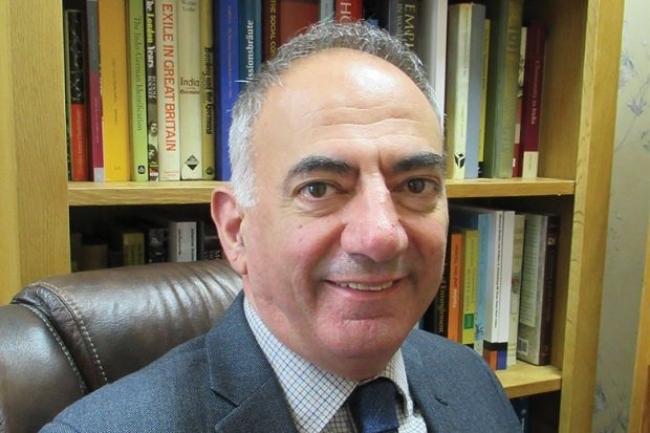Posts com a Tag ‘Europa – Escócia’
Migrant City: A New History of London | Panilos Panayi
Panilos Panayi | Imagem: Times Higher Education
According to a survey carried out by the National Federation of Fish Fryers in the 1960s, the first fish and chip shop was opened by Joseph Malins in 1860 on Old Ford Road in the East End of London (p. 234). The combination of the fried fish that had been sold and eaten in the Jewish East End since the early nineteenth century with chips created what became a quintessentially British meal. This is one of many examples included in Panikos Panayi’s Migrant City: A New History of London of how migrants have contributed to the culture and economy of London and in turn the United Kingdom.
Panayi makes clear the crucial role that migrants have played in the development of London as a global centre of trade, finance, culture, and politics. He ties this to London’s status as both the centre of a global empire and the largest city in the world for much of the nineteenth and twentieth centuries. More than half of migrants arriving in the United Kingdom from abroad moved to London, whose history of migration stretches back to its Roman founding. London, therefore, had long been cosmopolitan and by the late twentieth century had become ‘super-diverse’, with residents born in more than 179 countries, many beyond Europe or the former British Empire. Leia Mais
The Press and the People: Cheap Print and Society in Scotland/ 1500-1785 | Adam Fox
The Press and the People | Detalhe de capa
Early modern Scotland was awash with cheap print. Adam Fox, in the first dedicated study of the phenomenon in Scotland, gives readers some startling figures. Andro Hart, one of Edinburgh’s leading booksellers, died in 1622. In his possession, according to his inventory, were 42,300 unbound copies of English books printed on his own presses. John Wreittoun, also Edinburgh based, had in stock at his death in 1640 what Fox estimates to be 7,680 ‘waist littell scheittis of paper’, printed up as ‘littell pamphlettis and balladis’, and averaging a sale price of just 3d Scots (pp. 70-2). The inventory of Robert Drummond, drawn up, again in Edinburgh, in 1752, recorded a quantity of printed ‘small phamphlets’ and ‘ballads’ that Fox estimates amounted to 174,000 separate copies ready to go to market (p. 107). While historians of early modern print are well aware that the number of works we know about was once far surpassed by those now no longer extant, Fox’s examination of the inventories of Scotland’s printers and booksellers confirms the scale of the loss. It shows that Scottish printers were not predominantly producers of books and exposes a ‘vastly’ larger market for cheap print ‘than has ever been realised’ (p. 11). Leia Mais
Public Opinion in Early Modern Scotland/ c.1560–1707 | Karin Bowie
This is Karin Bowie’s second book about the history of public opinion in Scotland. Her first, in 2007, examined the period 1699-1707 in depth, covering the debate leading up to the Union of Parliaments.(1) The present book deals with a longer period, and has no single focus like the Union. Instead it discusses a larger range of political debates – and some religious debates, at least to the extent that these affected politics. Nevertheless, the questions driving the new book are similar. What was ‘public opinion‘, and how was it expressed? Or, what were people’s opinions, and how did they express them? The ‘public’ is never a singular thing that has a single opinion. Bowie’s book is thus about debate, and about processes of debate.
When historians discuss public opinion, what often interests us is the balance of opinion on debated topics. Was a given topic ‘popular’ or ‘unpopular’? Would a majority of the population have voted for or against (say) the Reformation at the time when it was being proposed? Historians of the early modern period cannot conduct opinion polls, but we recognise that the opinions that such polls would have measured did exist in some way. When we write of the ‘popularity’ of the Reformation, or indeed of its ‘unpopularity’, we are making statements that are to some extent psephological. Leia Mais
Four Nations Approaches to Modern ‘British’ History: A (Dis)united Kingdom | Naomi Lloyd-Jones e Margaret M. Scull
Naomi Lloyd-Jones | Imagem: Royal Historical Society
Four Nations Approaches, as the editors acknowledge from the start, follows in the footsteps of a very solid tradition of edited collections, brought about by the rise of ‘New British History’ in the 1990s and early 2000s. Unlike the majority of that scholarship, however, this volume focuses on the modern rather than the early modern period: the stated aim of this chronology is that it allows the historian to transcend the discussion of ‘state formation’ (p. 5, and see also p. 62). Hugh Kearney’s ‘four nations’ label is adopted here to highlight the fact that ‘the extent to which’ England, Scotland, Ireland, and Wales ‘shared a “British” history is interrogated, rather than assumed’ (p. 6), and the approach remains ‘pluralistic’ rather than ‘wholeistic’ (p. 5). ‘Interactions’, instead of ‘integration’, form the focus of analysis (p. 5).
On the whole, there are two dangers that the volume sets out to avoid: the Anglocentrism which is residual in J. G. A. Pocock’s work, and, almost inevitably, in many political and state-centred histories; and a backstaging of the differences and peculiarities of each nation in an effort to look at how they fit into a British ‘whole’. This backstaging usually leaves behind especially Wales, tacitly subsumed into England, and—as Krishan Kumar has most eloquently noted—England itself, whose supposed essence is often reduced to positional dominance in the Union and in the Empire.(1) In this historical moment, however, an explicitly dis-homogenising historiographical approach is made most relevant by the post-2016 trajectories not of Wales and England, but of Scotland and Northern Ireland (pp. 15-18). Lloyd-Jones and Scull are very aware of the risks of hindsight-thinking. That of coming to see the United Kingdom as less of a historical reality merely because of its present disgregation was an issue with which historians had to grapple already in the 1990s. (2) Yet in firmly choosing the Four Nations framework, and determinedly bypassing not only Anglocentric paradigms, but the very idea of ‘Britishness’, this book may well be riding an early wave of what will become the politically mainstream understanding of ‘British’ history. Leia Mais
Il Novecento della Cucirini Cantoni Coats. Lavoro/ territorio e conflittualità nella parabola lucchese della multinazionale tessile | Federico Creatini
Il nuovo volume di Federico Creatini1 , contenente un saggio di Andrea Ventura2 , ricostruisce le vicende della Cucirini Cantoni Coats, succursale lucchese della nota impresa multinazionale produttrice di filati con sede in Scozia, sino ad oggi oggetto di un interesse limitato e sporadico da parte della storiografia, presentando i risultati di un progetto di ricerca biennale promosso dall’Istituto Storico della Resistenza e dell’Età Contemporanea di Lucca e dedicato a ricostruire le vicende dello stabilimento e, più in generale, la memoria collettiva della vita di fabbrica nella città di Lucca. L’opera recepisce gli spunti offerti dal dibattito metodologico che ha interessato negli ultimi anni la storia del lavoro, che, superate le strettoie di un approccio rigidamente operaista (e marxista), si è aperta agli stimoli provenienti dalla global history, dalla storia di genere e dalla storia della conflittualità sociale e della subalternità3 , rileggendo le vicende sindacali e le trasformazioni aziendali della Cucirini Cantoni Coats alla luce di processi socio-culturali e ambientali più complessi, tanto di livello micro che di livello macro4. Leia Mais




